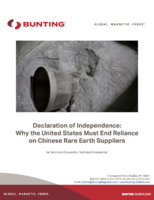IMM incorporates double turning-cube stack mold system.
Press Release Summary:
Available in 40-450 metric ton sizes, K-TEC injection molding machines (IMMs) utilize FOBOHA's double turning-cube stack mold system, which has 3 parting lines that allow one IMM to mold 2 precision parts from 2 materials, label, and assemble finished product. By mounting secondary injection unit at 45° angle on top of moving platen, machine saves floor space. Cycle time is reduced, because injection nozzle stays mated to hot runner system during clamp movement.
Original Press Release:
One Good Turn Deserves Another: New Double Turning-Cube Stack Mold System Produces Two Parts, from Two Materials, Assembles and Labels Them - in One Injection Machine
Cavity-registered assembly is exceptionally precise, ideal for packaging, medical, cosmetic, personal care and optical products
December 2004 - Milacron has added precision, cavity-registered assembly to the capabilities of the injection molding machine with its demonstration of FOBOHA's new double turning-cube stack mold system at K 2004. The double-cube system - developed and patent-pending by moldmaking leader FOBOHA (Haslach, Germany) - features three "parting lines," allowing a single injection machine to mold two precision parts, from two different materials, label and assemble the finished product. Demonstrated at the K show producing a two-component "lid within a lid," the double turning-stack system is ideal for high-volume packaging, medical, personal-care, cosmetic, electronic and optical components.
The K show demonstration system, built for a leading producer of smokeless tobacco, featured 16 cavities on each face of two cubes, set between the platens of a Ferromatik Milacron K-TEC 250 two-component injection machine. The finished part serves as a tiny lidded spittoon that's built into the tobacco can lid. The can lid is injected with red PP homopolymer on one face of cube A at the stationary end of the injection machine, while a smaller black PP lid is injected and in-mold labeled on the B-cube face that's opposite the moving platen. As the cubes index 90 degrees with each cycle of the machine, the finished parts on each cube face are snap-fit together at the center parting line, with the finished assembly removed by a robot on the next turn of the cube. Cycle time in the demo was about 6.5 sec.
The double spin-stack system is an evolutionary expansion of the turning cube stack mold, developed jointly by Milacron and FOBOHA, and introduced in 2001. "The original turning-cube stack system has quickly become a mainstream technology, and, not surprisingly, most of those systems are in the U.S. because we have the large population needed to consume the high output of these machines," noted Bob Hare, the U.S. general manager of Ferromatik Milacron. "What might come as a surprise is that custom molders own more of these systems than proprietary-product companies."
A clever new development Milacron introduced for the K show demo was mounting of the secondary injection unit at a 45 degree angle on top of the moving platen. "This not only saves all the floor space you'd normally need for a side-mounted secondary injection unit," Hare said, "but more importantly, it saves cycle time by allowing the injection nozzle to stay mated to the hot runner system during clamp movement."
The part demonstrated at the K show is currently being produced by two injection machines, with off-line assembly and labeling, so there's a benchmark to compare against, Hare stated. "The double turning-stack system can eliminate a second injection machine, all of its auxiliary equipment, a labeling system, an assembly machine, the energy cost to run all this, the extra labor, the maintenance cost, the controls/interfaces, the work-in-process inventory, and the inconsistency and scrap that result from secondary processes," he emphasized. "Output per square meter is higher, output per KWH is higher, and output per unit of capital cost is greater than any comparable technology for producing this part."
Ferromatik's K-TEC injection molding machine - available in 40-450 metric ton sizes - is an ideal platform for the cube stack mold. The machine's accumulator-based hydraulic system provides high constant flow rates to simultaneously drive the clamp, injection, and ejection sections of the machine. The basic machine can be combined with up to six injection units of different size for large-shot preforms and correspondingly smaller shots for secondary colors/materials. Pre-engineered options for extended tie-bar space and daylight accommodate large stack and cube molds easily. Multiple injection units are individually selectable and controllable with the push of a button at the control station, eliminating the need for special operator training. Equally important, the machine's control system has the processing power and software interface needed to manage concurrent operation of all the hardware in a complete manufacturing cell.
Turning-stack technology is cost-effective for both large and small production runs, because the system is also designed to be versatile, added Bob Strickley, marketing director for Cincinnati Milacron. It allows fast and trouble-free mold changes because all supply lines are integrated in the system and do not have to be reconnected during each mold change. "This is a potent technology for adding value to a part while it's still 'between the tie bars,' and it's being explored by a number of customers for applications on our larger machines," he stated.
For additional information on this and other Milacron manufacturing technologies, visit the web site at www.milacron.com.




